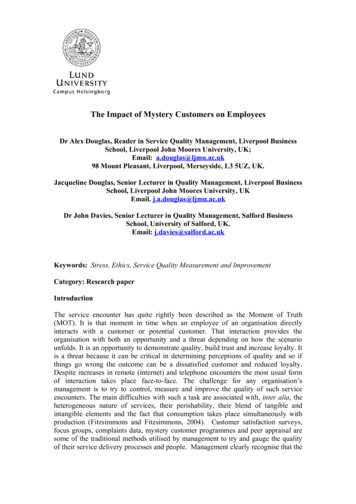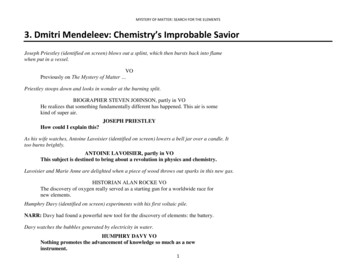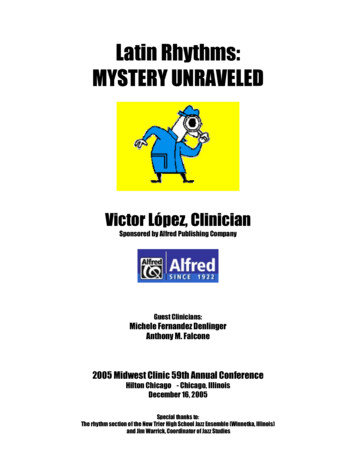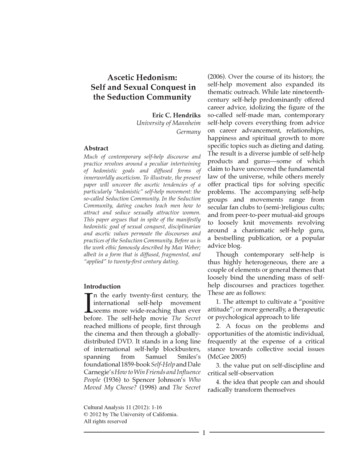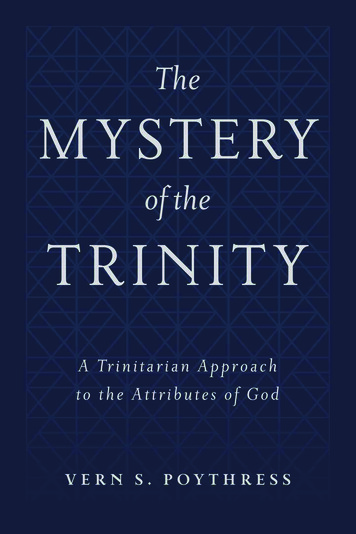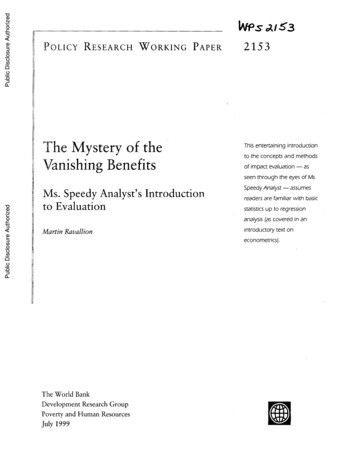
Transcription
Public Disclosure AuthorizedPublic Disclosure AuthorizedW s , 13POLICYRESEARCHWORKINGPAPERThe Mystery of theVanishingBenefits2153This entertaining introductionto the concepts and methodsof impactevaluation -asseen through the eyesof Ms.Ms. Speedy Analyst'sIntroductionSpeedyAnalyst-assumesto Evaluationstatisticsup to regressionanalysis(ascovered in anMartin Ravallionintroductorytext oneconometrics).Public Disclosure AuthorizedPublic Disclosure Authorizedreadersare familiarwith basicThe World BankDevelopmentResearchGroupPoverty and Human ResourcesJuly 1999
POLIcY RESEARCH WORKINGPAPER2153Summary findingsThe setting for this good-natured training guide forimpact evaluation is the fictional developing countryLabas. Twelve months ago the government introduced anantipoverty program in Northwest Labas with supportfrom the World Bank. The program aims to provide cashtransfers to poor families with school-age children. To beeligible to receive the transfer, households must haveobservable characteristics that suggest they are poor. Tocontinue receiving the transfer, they must keep theirchildren in school until 18 years of age. The program iscalled PROSCOL.The government wants to assess PROSCOL's impacton poverty, to help decide whether the program shouldbe expanded or dropped. The Finance Minister asks theundersecretary, and the undersecretary calls in Ms.Speedy Analyst.Ms. Speedy Analyst's on-the-job training in how toassess the impact of a social program provides the vehiclethrough which this paper explains:* Methods of evaluating a program's impactrandomizing, matching, reflexive comparisons, doubledifference (or "difference in difference") methods, andinstrumental variables methods.* The types of data used for impact evaluation, typicalproblems with and uses of data, control variables,instrumental variables, regressions, and so on.* How to form and match comparison groups.* Sources of bias.* The value of baseline surveys.* Measures of poverty (headcount index, poverty gapindex, and squared poverty gap).* How to compare poverty with and without theprogram.This paper -a product of Poverty and Human Resources, Development Research Group - is part of a larger effort in thegroup to provide useful training tools for Bank staff. Copies of the paper are available free from the World Bank, 1818 HStreet NW, Washington, DC 20433. Please contact Patricia Sader, room MC4-773, telephone 202-473-3902, fax 202-5221153, Internet address psader@worldbank.org. Policy Research Working Papers are also posted on the Web at kpapers/home.html.The author may be contacted at mravallion@worldbank.org. July 1999. (40 pages)The Policy Research Working Paper Series disseminates the findings of work in progress to encourage the exchange of ideas aboutdevelopment issues.An objective of the series is to get the findings out quickly, even if the presentations are lessthan fully polished. Thepapers carry the names of the authors and should be cited accordingly. The findings, interpretations, and conclusions expressed in thispaper are entirely those of the authors. They do not necessarily represent the view of the World Bank, its Executive Directors, or thecountries they represent.Produced by the Policy Research Dissemination Center
The Mysteryof the Vanishing Benefits:Ms Speedy Analyst's Introduction to EvaluationMartinRavallion*World BankThis paperaimsto providean introductionto the conceptsand methodsof impactevaluation.Thepaperassumesthat readersare familiarwith basicstatisticsup to regressionanalysis(as wouldbe coveredin an introductorytext on econometrics).For their commentsand discussionsI am gratefulto JudyBaker,Kene Ezemenari,EmanuelaGalasso,Paul Glewwe,JyotsnaJalan,EmmanuelJimenez,Aart Kraay,RobertMoffitt,RinkuMurgai,PedroOlinto,Berk Ozler,LauraRawlings,Dominiquevan de Walle,andMichaelWoolcock.
The setting for our story is the developingcountry,Labas. 12 months ago, its Governmentintroducedan anti-povertyprogram in NorthwestLabas, with supportfrom the World Bank. Theprogram aims to provide cash transfers to poor families with school-agechildren.To be eligible toreceive the transfer, households must have certain observablecharacteristicsthat suggest they are"4poor";to continue receiving the transferthey must keep their kids in school until 18 years of age.The program is called PROSCOL.The Bank's Country Director for Labas has just asked the Governmentto assess PROSCOL'simpact on poverty,to help determninewhetherthe program shouldbe expandedto include the rest ofthe country,or be dropped. The Ministryof Social Development(MSD)runs PROSCOL. However,the Bank asked if the Finance Ministry coulddo the evaluation,to help assure independence,and tohelp develop capacity for this type of evaluation in a central unit of the government-close to wherethe budgetaryallocations are being made. The Governmentagreed to the Bank's request. TheMinister of Financehas delegatedthe task to Mr. Undersecretary,who has called in one of hisbrightest staff, Ms Speedy Analyst.Four years ago, Speedy Analyst graduatedfrom the LabasNational University,where she dida Masters in AppliedEconomics. She has worked in the Finance Ministry since then. Speedy has areputationfor combining good common sensewith an ability to get the most out of imperfect data.Speedy also knows that she is a bit rusty on the stuff she learnt at LNU.Mr. Undersecretary gets straightto the point. "Speedy, the Governmentis spending a lot ofmoney on this PROSCOL program,and the Minister wants to know whetherthe poor are benefitingfrom it, and how much. Could you please make an assessment."Speedy thinks this sounds a bit too vague for her liking; what does he mean by "benefiting",she thinks to herself. Greater clarity on the program's objectives wouldbe helpful."I will try to do my best, Mr. Undersecretary. What, may I ask, are the objectives ofPROSCOL,that we should judge it against?"2
Mr. Undersecretarydoes not seem entirelycomfortablewith such a direct question. Heanswers: "To reduce poverty in Labas,both now and in the future."Speedytries to pin this down further."I see. The cash transfersaim to reduce current poverty,while by insistingthat transfer recipientskeep their kids in school, the programaims to reduce futurepoverty"."Yes, that's right, Speedy"."So I guess we need to knowtwo things about the program. Firstly,are the cash transfersmainly going to low-income families? Secondly,how much is the program increasing schoolenrollmentrates?""That should do it, Speedy. Here is the file on the program that we got from the Ministry ofSocial Development."Thus began Speedy Analyst's on-the-jobtraining in how to assess the impact of a socialprogram. Note 1 summarizes the methodsshe will learn about over the followingdays.The mystery unfoldsBack in her office, Speedy finds that the file from MSD includessome useful descriptivematerial on PROSCOL.She learnsthat targeting is done on the basis of various "poverty proxies",includingthe number of people in the household,the educationof the head,and various attributesofthe dwelling. PROSCOL pays a fixed amountper school-agechild to all selectedhouseholds on theconditionthat the kids attend 85% of their school classes, which has to be verifiedby a note from theschool.3
Note 1: Methods for evaluating program impactThe essential problem of impact evaluation is that we do not observe the outcomes for participants ifthey had not participated. So evaluation is essentially a problem of missing data. A "comparison group"is used to identify the counter-factual of what would have happened without the program. Thecomparison group is designed to be representative of the "treatment group" of participants with one keydifference: the comparison group did not participate. The main methods available are as follows:* Randomization, in which the selection into the treatment and comparison groups is random in somewell-defined set of people. Then there will be no difference (in expectation) between the twogroups besides the fact that the treatment group got the program. (There can still be differences dueto sampling error; the larger the size of the treatment and comparison samples the less the error.)* Matching. Here one tries to pick an ideal comparison group from a larger survey. The comparisongroup is matched to the treatment group on the basis of a set of observed characteristics, or usingthe "propensity score" (predicted probability of participation given observed characteristics); thecloser the propensity score, the better the match. A good comparison group comes from the sameeconomic environment and was administered the same questionnaire by similarly trainedinterviewers as the treatment group.* Reflexive comparisons, in which a "baseline" survey of participants is done before the intervention,and a follow-up survey done after. The baseline provides the comparison group, and impact ismeasured by the change in outcome indicators before and after the intervention.* Double difference (or "difference in difference") methods. Here one compares a treatment andcomparison group (first difference), before and after a program (second difference). Comparatorsshould be dropped if they have propensity scores outside the range observed for the treatmentgroup.* Instrumental variables methods. Instrumental variables are variables that matter to participation,but not to outcomes given participation. If such variables exist then they identify a source ofexogenous variation in outcomes attributable to the program - recognizing that its placement is notrandom but purposive. The instrumental variables are first used to predict program participation,then one sees how the outcome indicator varies with the predicted values.No method is perfect. Randomization is fraught with problems in practice. Political feasibility is often aproblem. And even when selection is randomized, there can still be selective non-participation.Matching methods only deal with observable differences; there will still be a problem of latentheterogeneity, leading to a possible bias in estimating program impact. Selective attrition plagues bothrandomization and double-difference estimates. It is always desirable to triangulate methods.The file includes a report, "PROSCOL: Participants' Perspectives", commissioned by MSDand done by a local consultant. The report was based on qualitative interviews with programadministrators and focus groups of participants. Speedy cannot tell whether those interviewed wererepresentative of PROSCOL participants, or how poor they are relative to those who were not pickedfor the program and were not interviewed. The report says that the kids went to school, but Speedywonders whether they might not have also gone to school if the program had not existed.4
Speedy reflects to herself. "This report is a start, but it does not tell me how poor PROSCOLparticipants are and what impact the program has on schooling. I need hard data." Later Speedyprepares Note 2, summarizing the types of data typically used in impact evaluations.Note 2: Data for impact evaluation**********Know the program well. It is risky to embark on an evaluation without knowing a lot about theadministrative/institutional details of the program; that information typically comes from theprogram administration.It also helps a lot to have a reasonably firm grip on the relevant "stylized facts" about the setting.The relevant facts might include the poverty map, the way the labor market works, the majorethnic divisions, other relevant public programs, etc.Be eclectic about data. Sources can embrace both informal, unstructured, interviews withparticipants in the program as well as quantitative data from representative samples.However, it is extremely difficult to ask counter-factual questions in interviews or focus groups;try asking someone who is currently participating in a public program: "what would you be doingnow if this program did not exist?" Talking to program participants can be valuable, but it isunlikely to provide a credible evaluation on its own.One also needs data on the outcome indicators and relevant explanatory variables. You need thelatter to deal with heterogeneity in outcomes conditional on program participation. Outcomes candiffer depending on whether one is educated, say. It may not be possible to see the impact of theprogram unless one controls for that heterogeneity.Depending on the methods used (Note 1), you might also need data on variables that influenceparticipation but do not influence outcomes given participation. These instrumental variables canbe valuable in sorting out the likely causal effects of non-random programs (Note 1).The data on outcomes and other relevant explanatory variables can be either quantitative orqualitative. But it has to be possible to organize it in some sort of systematic data structure. Asimple and common example is that one has values of various variables including one or moreoutcome indicators for various observation units (individuals, households, firms, communities).The variables one has data on and the observation units one uses are often chosen as part of theevaluation method. These choices should be anchored to the prior knowledge about the program(its objectives of course, but also how it is run) and the setting in which it is introduced.The specific source of the data on outcomes and their determinants, including programparticipation, typically comes from survey data of some sort. The observation unit could be thehousehold, firm, geographic area, depending on the type of program one is studying.Survey data can often be supplemented with useful other data on the program (such as from theproject monitoring data base) or setting (such as from geographic data bases).There is a promising lead in the MSD file. Nine months ago the first national householdsurvey of Labas was done by the Labas Bureau of Statistics (LBS). It is called the Living StandardsSurvey (LSS). The survey was done for a random sample of 10,000 households, and it asked abouthousehold incomes by source, employment, expenditures, health status, education attainments, and5
demographicand other attributes of the family. There is a letter in the file from MSD to LBS, a fewmonths prior to the LSS, asking for a questionto be added on whetler or not the sampled householdhad participatedin PROSCOL.The reply from LBS indicatesthat the listingof income sources in thesurvey schedulewill include a line item for money received from PROSCOL."Wow", says Speedy, and she heads off to LBS.Speedy Analyst already knowsa few things about the LSS, havingused tabulations from itproduced by LBS. But Speedy worriesthat she will not be able to do a good evaluation ofPROSCOLwithout access to the raw household-leveldata. But after a protractedand unsuccessfuldiscussionwith the head of the LBS unit in charge of the survey, and seeminglyendless follow-upphone calls, Speedy starts to worrywhethershe will get the data, and have anything on outcomesworth showingher boss.However,after a formal request from the Minister (which Speedy wrote for him to sign), theSecretaryof Statistics finally agreesto give her the micro data. Then, after a few more phone calls,LBS also gives her a copy of the documentationshe needs to readthe data.Speedy already knows how to use a statistics package called SAPS. After a long and painfulday figuringout how to use the raw LSS data, Speedy starts the real work.She uses SAPS to make across-tabof the average amount receivedfrom PROSCOL by deciles of households, where thedeciles are formed by ranking all householdsin the sample accordingto their income per person. Incalculatingthe latter, Speedy decidesto subtract any monies receivedfrom PROSCOL; this, shereckons, will be a good measure of income in the absence of the program. So she hopes to revealwho gainedaccording to their pre-interventionincome.The cross-tab suggeststhat the cash transfers under the programare quite well targeted to thepoor. By the official LBS povertyline, about30% of NorthwestLabas' population is poor. From hertable, she calculates that the poorest 30% of the LSS sample receive70% of the PROSCOL transfers.This looks like good news for PROSCOL,Speedy reflects.6
What about the impact on schooling? She makes another table, giving average schoolenrollmentrates of various age groupsfor PROSCOL familiesversus non-PROSCOLfamilies. Thissuggestsalmost no difference betweenthe two; the average enrollmentrate for kids aged 6-18 isabout 80% in both cases.Speedy then calculates averageyears of schooling at each age and plots the results separatelyfor PROSCOLfamilies and non-PROSCOLfamilies. The two figures are not identical, but they arevery close."Was there really no impacton schooling,or have I done somethingwrong?" she asksherself. The question is just the beginningof the story of how SpeedyAnalyst solves the mysteryofthe vanishingschooling benefits from PROSCOL.Speedy Analyst visits Mr. Unbiased StatisticaSpeedy decides to show her curiousresults to a couple of trusted colleagues. First she visitsMr. Unbiased Statistica, a senior statisticianat LBS. Speedy likes Statistica,and feels comfortableasking him about statistical problems."Mr Statistica, my calculationsfrom the LSS suggest that PROSCOLkids are no more likelyto be in school than non-PROSCOLkids. Have I done somethingwrong?"Statisticatells her bluntly:"Speedy, I think you may well have a serious bias here. To knowwhat impactPROSCOL has, you needto know what would have happen withoutthe program. Thegain in schoolingattributable to the programis just the difference betweenthe actual schoolattendance rate for participatingkids and the rate for those same kids if the program had not existed."What you are doing Speedyis using non-PROSCOLfamiliesas the comparison group forinferringwhat the schooling wouldbe of the PROSCOLparticipants if the program had not existed.This assumesthat the non-participantscorrectlyreveal, at least on average, schooling without theprogram. Some simple algebra might help make this clear."7
Mr. Statisticastarts writing. "Let Pidenote PROSCOLparticipationof the i'th child. This cantake two possible values, namely Pi I when the child participates in PROSCOLand Pi 0 when shedoes not. When the i'th child does not participate,her level of schooling is S0iwhich stands for childi's schoolingS when P O. When the child does participateher schooling is Sli. The gain inschooling due to PROSCOLfor a child that does in fact participateis:G, SIi-So,JPi l"Why do you need this I "? asks Speedy."That stands for 'given that' or 'conditional on' if you prefer. The''is needed to makeit clear that we are calculating the gain for a child who actually participated. If we want to knowthe average gain we simply take the mean of all the G's. This will give you the sample meangain in schooling amongst all those who participated in PROSCOL. As long as you havecalculated this mean correctly (using the appropriate sample weights from your survey) it willprovide an unbiased estimate of the true mean gain. The latter is what statisticians often call the"expected value" of G, and it can be written as:G E(SI -SoiIPi 1)You can think of this as another way of saying 'mean'. However, it need not be exactly equal to themean you calculatefrom your sample data, giventhat there will be some samplingerror. In theevaluation literature, E(S1-So, IPi l) is sometimes called the 'treatment effect' or the 'averagetreatment effect on the treated'."Speedy thinks to herself that the governmentwould not like to call PROSCOLa "treatment".But she is elated by Statistica's last equation. "Yes Mr. Statistica,that is exactlywhat I want toknow."8
"Ah, but that is not what you have calculatedSpeedy. You have not calculatedG but ratherthe difference in mean schoolingbetween kids in PROSCOLfamilies and those in non-PROSCOLfamilies. This is the sample estimate of:D E(Sli I Pi l) - E(So0 IPi O)There is a simple identitylinking the D and G, namely:D G BThis term 'B' is the bias in your estimate, and it is givenby:B E(SojI Pi 1) - E(So,I P1 0)In other words, the bias is the expecteddifference in schoolingwithout PROSCOLbetween childrenwho did in fact participatein the program and those who did not. You could correct for this bias ifyou knew E(So0 IP, l). But you can't even get a sampleestimate of that. You can't observe what theschooling would have been of kids who actually participatedin PROSCOL had they not participated;that is missing data - it is called a 'counter-factual' mean."Speedy sees that Statisticahas a legitimateconcern.In the absence of the program,PROSCOLparents may well send their kids to school less than do other parents. If so, then there willbe a bias in her calculation.What the Finance Ministerneeds to know is the extra schoolingdue toPROSCOL. Presumablythis only affects those familieswho actually participate.So the Ministerneeds to know how much less schoolingcould be expectedwithout the program.If there is no bias,then the extra schoolingunder the program is the differencein mean schoolingbetweenthose whoparticipatedand those who did not. So the bias arises if there is a difference in mean schoolingbetween PROSCOLparents and non-PROSCOLin the absenceof the program."What can be done to get rid of this bias, Mr. Statistica?""Well, the best way is to assign the programrandomly.Then participantsand nonparticipants will have the same expected schoolingin the absence of the program,i.e., E(So0 I P l)E(So,IPi O). The schoolingof non-participatingfamilieswill then correctlyreveal the counter9
factual, i.e., the schoolingthat we would have observed for participantshad they not had accesstothe program. Indeed, random assignmentwill equate the whole distribution,not just the means.There will still be a bias due to samplingerror, but for large enough samplesyou can safely assumethat any statisticallysignificantdifference in the distributionof schoolingbetween participantsandnon-participants'is due to the program."On recalling what she read in the .PROSCOLfile, Speedyrealizesthat she need look nofurther than the design of the programto see that participationis not random. Indeed, it would be aserious criticism of PROSCOLto find that it was. The very fact of its purposivetargeting to poorfamilies,who are presumably less likely to send their kids to school,would create bias.She tells Mr. Statisticaaboutthe program's purposiveplacement."So, Speedy, if PROSCOLis working well then you shouldexpect participants to have worseschoolingin the absence of the program. Then E(SoiIP, 1) E(SoiIPi 0) and your calculationwillunderestimatethe gain from the program. You may find little or no benefit even though the programis actually working well."Speedy returns to her office, despondent.She sees now that the magnitude of this bias thatMr. Statistica is worried about couldbe huge. Her reasoningis as follows: Supposethat poor familiessend their kids to work rather than school; because they are poor and cannotborrow easily, they needthe extra cash now. Non-poor familiessend their kids to school. The programselects poor families,who then send their kids to school.One observes negligibledifference in mean schoolingbetweenPROSCOLfamilies and non-PROSCOLfamilies; indeed, E(Sj1 I Pi 1) E(Soi I Pi 0) inexpectation. But the impact of the program is positive, and is givenby E(SoiI Pi 0) - E(SoiI Pi 1).The failure to take account of the program's purposive, pro-poor,targeting could well have led to avery substantial under-estimationof PROSCOL's benefits from her comparisonof mean schoolingbetween PROSCOL families and non-PROSCOLfamilies.10
A visit to Ms Tangential EconomisteNext Speedy visits a colleagueat the Ministry of Finance,TangentialEconomiste. Tangentialspecializesin public finance. She has a reputationas a sharp economist in the Ministry, thoughsometimes a little brutal in her commentson her colleague's work.Speedy first shows her the cross-tabof amounts receivedfrom PROSCOLagainst income.Tangential immediatelybrings up a concern,which she chastises Speedy for ignoring."You haveclearly overestimatedthe gains to the poor from PROSCOLbecauseyou have ignored foregoneincome, Speedy. Kids have to go to schoolif the family is to get the PROSCOLtransfer. So theywill not be able to work, either on the familybusiness or in the labor market. Kids aged 15-18 canearn two-thirds or more of the adult wage in agriculture and construction,for example. PROSCOLfamilies will lose this income from their kids' work. You shouldtake account of this foregoneincome when you calculate the net incomegains from the program.And you should subtract this netincome gain, not the gross transfer,to work out pre-interventionincome. Onlythen will you knowhow poor the family would have been is in the absence of the PROSCOLtransfer. I reckon this tablemight greatly overstate the program's gains to the poor.""But why should I factor out the foregone income from child labor? Less child labor issurely a good thing," Speedy says in defense."You should certainly look at the gains from reducing child labor Speedy, of which themain gain is no doubt the extra schooling, and hence higher future incomes of currently poorfamilies. I see your next table is about that. As I see it, you are concerned with the two mainways PROSCOL reduces poverty: one is by increasing the current incomes of the poor, and theother is by increasing their future incomes. The impact on child labor matters to both, but inopposite directions. So PROSCOL faces a trade off."11
Speedy realizes that this is another reason why she needs to get a good estimate of theimpact on schooling; only then will she be able to determine the foregone income that Tangentialis so worried about. Maybe the extra time at school comes out of non-work time.Next, Speedy tells Tangential about Mr. Statistica's concerns about her second table, tosee what she thinks."I think your main problemhere is that you have not allowed for all the other determinantsofschooling,besides participationin PROSCOL. You should run a regressionof years of schoolingona set of control variables as well as whether or not the child's family was covered by PROSCOL.Why not try this regression?" Tangentialwrites. "For the i'th child in your sample let:Si a bPi cX, siHere a, b and c are parameters,X standsfor the control variables,such as age of the child, mother'sand father's education,the size and demographiccompositionof the household and schoolcharacteristics,while E is a residualthat includes other determinantsof schooling,and measurementerrors. You can see Speedy that the estimatedvalue of b gives you the impact of PROSCOLonschooling.""No, I don't see that," Speedyinterjects."Well, if the family of the i'th child participates in PROSCOLthen P 1 and so its schoolingwill be a b cX, si. If it does not participate,then P Oand so its schooling will be a cX1 i.The difference between the two is the gain in schoolingdue to the program,which is just b."This discussion puts Speedy in a more hopeful mood, as she returns to her office to try outTangential's equation. She runs the REGRESScommand in SAPSon the regression with andwithout the control variables Tangentialsuggested. When she runs it without them, she finds that theestimatedvalue of b is not significantlydifferent from zero (usingthe standardt-test given by SAPS).This looks suspiciously like the result she first got, taking the differencein means between12
participants and nonparticipants-suggestingthat PROSCOLis not having any impact onschooling. However, when she puts a bunch of control variables in the regression, she immediatelysees a positive and significantcoefficienton PROSCOLparticipation. She calculates that by 18years of age, the program has addedtwo years to schooling.Speedy thinks that this is startingto look more convincing.But she feels a little unsure aboutwhat she is doing. "Why do these control variables make such a difference? And have I used theright controls? I need more help if I am going to figure out what exactly is going on here, andwhether I should believethis regression."Professor Chisquare helps interpret Speedy's resultsSpeedy decides to visit Professor Chisquare,who was one of her teachers at LNU. Chisquareis a funny little man, who wears old-fashionedsuits and ties that don't match too often. "It isjust notnormal to be so square", she recalls thinking during his classes in econometrics. Speedy also recallsher dread at asking Chisquareanything,because his answerswere sometimes very hard tounderstand."But he knows more about regressions than anyoneelse I know", Speedy reflects.She arranges a meeting. Having heard on the phone what her problem is, Chisquaregreets hisex-studentwith a long list of papers to read, mostly with rather impenetrabletitles, and published inseeminglyobscure places."Thanks very much Professor,but I don't think I will have time to read all this before myreport is due. Can I tell you my problem, and get your reactions now?"Chisquare agrees. Speedyshows him the regressions,thinkingthat he will be pleased that hisex-studenthas been running regressions. He asks her a few questionsabout what she had done, andthen rests back in his chair, ready, it seems, to pronouncejudgement on her efforts so far.13
"One concern I have with your regressionof schoolingon P and X is that it does not allowthe impact of the program to vary with X; the impact is the same for everyone,which does not seemvery likely.""Yes, I wondered about that," chips in Speedy. "Parents with more schoolingwould be morelikely to send their kids to school, so the gains to them from PROSCOLwill be lower"."Quite possibly, Ms Analyst. To allowthe gains to vary with X, let mean schooling of nonparticipantsbe ao coXiwhile that of participantsis a, c1 Xi, so the observedlevel of sc
Sep 10, 1999 · The Mystery of the This entertaining introduction Vanishing Benefits to the concepts and methods of impact evaluation -as seen through the eyes of Ms. Ms. Speedy Analyst's Introduction Speedy Analyst-assumes readers are familiar with basic to Evaluation statistics up to regression analysi


